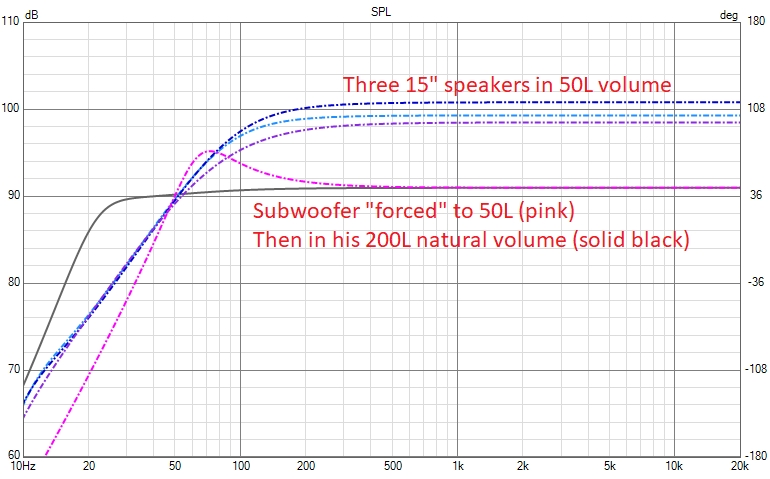Woofer Low End and EQ
This article explores how a woofer’s sensitivity, maximum SPL (Sound Pressure Level), and enclosure volume impact its low-end performance.
While EQ (equalization) can be used to adjust the frequency response, achieving powerful bass often relies more on these core factors.
Relation Between Emissive Surface and Enclosure Volume
Woofer size (diameter) plays a role, but for similar sized woofers, the enclosure volume significantly affects how deep the bass extends.
A larger enclosure typically allows a woofer to reproduce lower frequencies more efficiently.
The optimal enclosure size depends on the specific woofer’s parameters and desired response.
Here is four 15" compared in low end with the same amount of energy (2.84V):

We can see the effect of sensitivity on the speaker’s output, but it doesn’t impact low-end response below 50hz for the same amount of power amplification if the box volume is the same (all drivers have the same diameter).
When we use the recommended enclosure volume of 200L for this subwoofer, we see that we gain significant SPL in the very low end.
Woofer characteristics
Sensitivity indicates how loud a woofer gets with a given amount of volt. A higher sensitivity woofer will produce more SPL at lower amplifier volt levels. However, sensitivity doesn’t directly translate to how much low-end a woofer can handle.
A woofer with a higher maximum SPL, often related to X-max, can handle more power before breaks.
However in low end regions distortion is mainly linked to extrusion, the more the emitting surface moves the more distortion we will have. Sensitivity or even EQ just change the amount of energy needed to move.
Choosing a woofer with higher breakup frequencies ensures less associated distortion even if we have seen in breakup article that there are some important tricks about it.
The air core inductors with active filtering solution especially work well in the case of high sensitivity PA drivers.
EQ and High-Sensitivity Woofers
At the same woofer size, understanding the same emitting surface, and same load, aka the charge volume of the speaker (volume of the box), the level below 50hz will be globally close for the same amount of energy (Volt given by power amplifier).
Even if we equalize our high-sensitivity woofer to match the low-end response of another lower-sensitivity woofer in the same box volume, there likely won’t be a significant difference in distortion.
This is because low-end distortion is primarily caused by cone physical movement (extrusion), which affects all woofers of the same size similarly regardless of sensitivity.
So in the case of High-Sensitivity Woofers it is not a problem to add -3dB high shelf in low end to create a flatter response in low ends frequencies.
Conclusion
While achieving powerful and clean bass often relies on a woofer’s inherent qualities like sensitivity, SPL, and Fs, high-sensitivity woofers offer some flexibility with EQ to have a flatter low end response.
Adding a slight -3dB high shelf EQ in the low end increase bass without a significant rise in distortion compared to another woofer in the same enclosure volume that would achieve the same response without EQ.
This is because woofers with the same size, enclosure volume, and emitting surface will produce similar sound pressure levels at low frequencies for the same amount of volt.
Furthermore, since low-end distortion is primarily caused by cone movement (extrusion), all woofers with the same diameter will experience similar levels of extrusion at the same decibel level, regardless of the amount of energy sent (sensitivity at the frequency).
However, it’s important to remember that EQ adjustments alter the speaker’s designed frequency response, so we should stay minimal in our EQ adjustments.